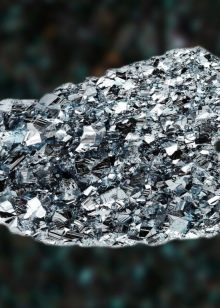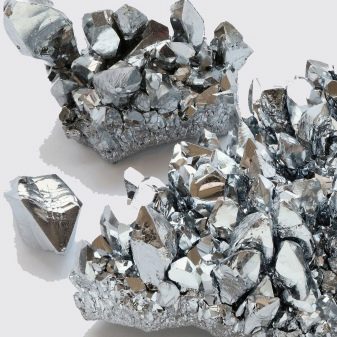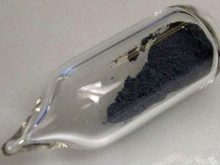Osmium - a rare metal, belongs to the platinum group. It was discovered in England as a result of experiments on the reaction of platinum. The name osmium is given in Greek and means “smell” in translation. What is this noble metal? What are its features and what is its use?

History
The discovery of this element happened by chance in 1803 by British chemists Smithson Tennant and William H. Wallastan. As a result of experiments on the reaction of platinum on a mixture of acids (sulfuric and nitric), the resulting precipitate showed an unpleasant aroma reminiscent of the stink of chlorine and rotten radish. Similar experiments were carried out by Colle Descotti, Antoine de Fourcoy and Vauclins in France. As a result of their research, they also found an unknown substance in an insoluble precipitate from platinum.



The unknown substance was then given the name pten, but the British experiments proved that these are two similar substances - iridium and osmium.
The discovery of these chemical elements was presented to the Royal Society in London by a written message from Tennant dated June 21, 1804. In the periodic table of chemical elements, the metal is located under the ordinal number 76. Metal is not found in its pure form by nuggets, therefore its chemical formula is presented in dissolved form.


Element mining is from recycled materials. as a result of its separation from iridium, platinum, platinum-palladium ore or copper and nickel ores. The annual output of the entire element in the world does not exceed the size of 1 ton.


Place of Birth
The world's largest deposits are worth noting such areas as Ural mountains and Siberia in Russia, the northern state Alaska and western state California in America, Canada in North America, Colombia in South America and some South African countries, Australia, Isle Tasmania. Currently, a significant deposit of osmium is considered Bushel complex in South Africa, they get the most stuff there. Given that the largest metal deposits are in South Africa, the world prices for this rare-earth metal are quite high. Kazakhstan It is considered the only major exporter of osmium-187 in the world. Although China has reserves of platinum ore, it does not have a significant amount of osmium.


The substance is stored in powder form and since it does not melt in the form of crystals, it is not possible to put a mark on it because of its physical properties. For the manufacture of ingots of this metal, electron-beam or arc heating from powder is used; heating in a crucible is also used.


The properties
Osmium looks like a silver-blue metal. This is one of the densest elements, its density is 22,600 kilograms per cubic meter, but at the same time, the substance is quite fragile, easily breaks and crumbles. It has a high specific gravity and is able to shine even at fairly high temperature influences. Due to the parameters and the significant melting temperature, it is difficult to machine it. In nature, it exists in the form of seven isotopes, six of which are considered stable, these are osmium-184, osmium-187, osmium-188, osmium-189, osmium-190 and osmium-192. Radioactive metal isotopes with mass numbers from 162 to 197 were laboratory-obtained, and some nuclear isomers were also artificially obtained.
Osmium in its characteristics adversely affects all living organisms.

Almost all compounds with this metal cause damage to internal organs, visual, auditory disorders. In case of poisoning by osmium pairs, irreversible disorders in the body and death can occur. Scientists conducted experiments on animals, the results of which were the rapid development of anemia, the lack of normal pulmonary function. It was concluded that this is a rapidly developing edema. Osmium tetraoxide, which is used in medicine, is a very aggressive substance. It has the most vile smell in the world. When poisoning, the skin suffers, it changes color to green or black, often this is accompanied by ulcers and cracks that will take a very long time to heal.



Employees of industrial premises are at the highest risk; according to all safety standards, they work only in respirators and special clothing. All containers containing osmium oxide are sealed and stored in accordance with the regulations. To obtain Nevyanskite minerals, platinum is converted into a solution by means of aqua regia. Then, the resulting precipitate is treated with zinc in an 8-fold amount - this alloy is relatively easily converted into a powder state, which is then fused with barium peroxide. The next step is the processing of the resulting mass using aqua regia, distillation through an apparatus for the separation of osmium tetroxide.

By exposing the substance to an alkali solution, salt is obtained. Salt solution is affected hyposulfiteAs a result, with the help of ammonium chloride, the metal precipitates already in the form of a Fremy salt. The precipitate is washed, filtered and calcined. The result of all these actions is spongy osmium. Subsequently, it is cleaned with acids, restored in an electric furnace under a stream of hydrogen, and cooled. So receive osmium samples up to 99.9%.


Chemical
The properties of this element, from the point of view of chemistry, are amazing. The following are considered the most basic of them.
- Osmium does not react at all with alkalis and acids. Forms water-soluble osmata in reaction with alkaline melts. Interaction with a mixture of nitric and hydrochloric acids gives an extremely slow reaction.
- Very toxic, even at microscopic doses. Especially toxic is osmium oxide released from platinum.
- It is impossible to determine the boiling temperature of the metal, since it is particularly refractory.
- Metal in powder easily reacts with the following substances: pure oxygen, halogens, sulfuric or nitric acids.
- In various compounds it receives oxide numbers from -2 to +8. The most common are +2, +3, +4 and +8.
- Capable of forming cluster compounds.
- The main minerals are related to solid solutions and are represented by alloys of iridium with osmium - these are sysertskite and nevyanskite. Moreover, syrskite has a different name - iridium osmium, and nevyanskite - osmisty iridium.

Physical
Density Osmium is approximately 22.61 grams per cubic centimeter. The crystals have a beautiful silvery sheen, with various tints from gray to blue. The ingots show a dark blue color, in the powder violet. All metal has a silvery sheen. The toxicity of the element does not allow its use in the jewelry industry. The main physical properties are noted such.
- The melting point of this element is quite high, melting is possible at a temperature of more than 3000 degrees Celsius.
- The metal has no magnetic properties.
- Amazing hardness. Alloys with the addition of this metal acquire increased wear resistance, durability, anticorrosion, and resistance to mechanical stress.
- The boiling point is 5012 ºC.
- Mohs hardness is 7.
- Vickers hardness is 3-4 GPa.

Fields of application
Due to the significant cost of the element itself, this metal is rarely used in mass industrial production. The scope of osmium is mainly represented by industry in the chemical industry, where it is used as a catalyst. Osmium tetraoxide is used as part of some drugs. In laboratory tests, it is used for staining living tissues, ensures the preservation of cell structure.
In the aerospace industry, osmium is used in electronic equipment of equipment for aviation and rocket technology, as well as in the manufacture nuclear weapons. Due to the lack of magnetic properties, metal is used in the manufacture of branded watches such as Rolex. An alloy of osmium with platinum is used for creating surgical implants - These are pacemakers or pulmonary trunk valves.
In addition, osmium is used in microscopy and to create high-precision devices.



Interesting Facts
- At a pressure of about 770 GPa, osmium interacts with electrons in internal orbitals, the structure of the substance remains unchanged.
- Osmium in rocks contains half a percent of the total mass of ore deposits.
- Due to high density the appearance and actual mass of the metal are very different. So, a 0.5-liter plastic bottle filled with this metal powder will be heavier than a 10-liter bucket filled with water.
- This metal is in the top five costly.
- The cost of a triple ounce of osmium is a trade secret, in open sources you can find the approximate price for 1 gram of substance.
- Due to the refractoriness of osmium noted in the history of the electric lamp. The scientist K. Auer von Welsbach from Germany made a proposal to replace a filament of osmium in a coal bulb. The bulbs turned out to be 3 times less energy-intensive, and the lighting improved markedly. True, he was soon replaced by the more common tantalum, which, in turn, was replaced by tungsten.
- A similar situation happened with rare metal and in ammonia production. The ammonia synthesis method currently used, developed in 1908 by the chemist Fritz Haber from Germany, is impossible without the use of catalysts.Initially, the catalysts used at that time showed their properties only in the presence of significant temperature conditions and did not have high efficiency, so the search for a replacement was very relevant. Scientists from the laboratory of the Higher Technical School in Karlsruhe have proposed the use of finely dispersed osmium in the form of a catalytic element. The test results confirmed that this idea was worthwhile, the catalytic temperature decreased by more than 100 ºC, and the ammonia output increased significantly. True, they later refused osmium, but it helped in solving such an important problem.

Osmium and other rare and unique metals play significant role in various industries. Even with all its toxicity, it saves the lives and health of people.
You can get more information about osmium in the next video.










